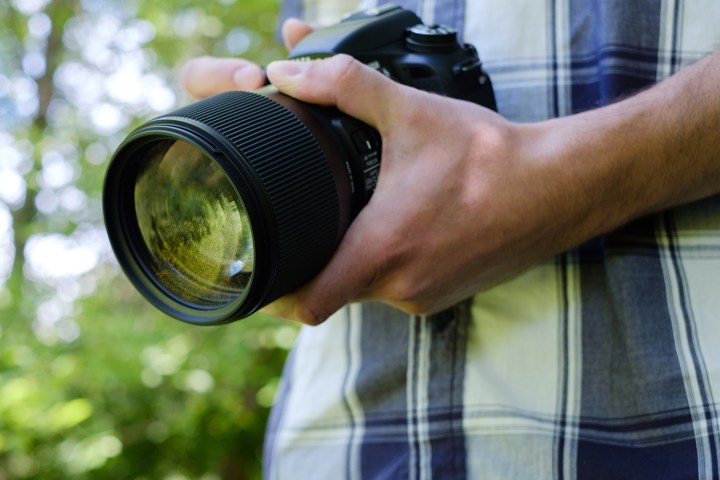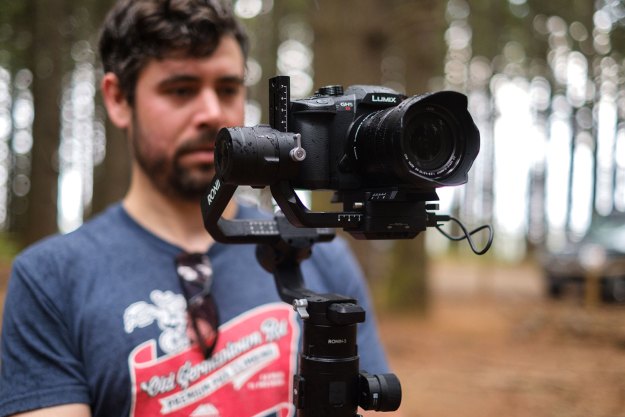Sigma has long been a favorite third-party lens company for combining high quality and low price. Whether you shoot Canon, Nikon, Sony, or an L-Mount camera from Leica, Panasonic, or Sigma, Sigma a number of lenses to choose from.
Nearly every lens on this list comes from Sigma’s Art series, lenses built for pixel peepers who want the most sharpness with the brightest apertures. Any Sigma lens with Art in the name that we’ve tested — out of dozens of lens tests — has met or exceeded our expectations. We’ve said it before — if Sigma has an Art lens for that focal length that you need, you should probably add it to your bag. Sigma’s Contemporary line is more affordable, while the Sport line is designed for, well, sports photography.
Here are our favorite Sigma lenses from wide-angle to telephoto.
At a glance:
- Best Sigma wide-angle zoom: 14-24mm F2.8 Art
- Best Sigma wide-angle prime: 35mm F1.2 Art
- Best Sigma portrait lens: 105mm F1.4 Art
- Best Sigma telephoto prime: 135mm F1.8 Art
- Best Sigma telephoto zoom: 150-600mm F5-6.3 Sports
Sigma 14-24mm F2.8 DG HSM Art

Best Sigma wide-angle zoom
Why you should buy this: Exceptionally sharp images meets rugged build quality in this ultra-wide angle
Who’s it for: Any photographer that needs a bright wide-angle, with a little zoom versatility
Why we picked the Sigma 14-24mm F2.8 Art:
Ultra-wide lenses are challenging optics to design, but Sigma manages to not only squeeze in 14-24mm focal lengths, but does so with excellent sharpness. We were equally impressed by the lens’ lack of chromatic aberration, or colored fringing. Despite the wide focal length and high-end build, Sigma has managed to mix in a bright f/2.8 aperture.

In keeping with Art series tradition, the 14-24mm is dust and splash proof with a rugged build that feels like it will last. That build and high-end glass, however, has a weight trade-off. It weighs 40 ounces and is hardly a pancake lens. The rounded glass at the front also means that you can’t use this lens with a screw-on filter.
Still, while this lens may be heavy, the image quality, build, and price are excellent. It is worth a look for any photographer that needs that bright wide-angle. This is the older DSLR variant here, available for Canon EF, Nikon F, and Sigma SA mounts, but Sigma has a new, mirrorless-only version with updated optics and a significantly reduced footprint for E-Mount (Sony) and L-Mount (Leica, Panasonic, Sigma) cameras.
Read the full Sigma 14-24mm f/2.8 DG HSM Art review
Sigma 35mm F1.2 DG DN Art

Best Sigma wide-angle prime
Why you should buy this: The ideal 35mm lens with exceptional sharpness and bokeh
Who’s it for: Perfectionists with a big budget
Why we picked the Sigma 35mm F1.2 Art:
The Sigma 35mm F1.2 DG DN Art is one of the best full-frame 35mm lenses out there — and might be the best. True to the Art series name, the lens offers exceptional sharpness and imperceptible distortion. Designed with high-end optics including three aspherical elements, there’s virtually no chromatic aberration.

Even the biggest bokeh fans will be satisfied with the blur from the f/1.2 aperture, which also makes this a great lens for working in limited lighting — although vignetting is quite strong at f/1.2.
On the outside, the lens is dust and splash resistant and includes a focus lock and aperture de-click switch. Of course, with all of that, the lens is no lightweight at roughly 38.5 ounces. It nearly feels like it needs a tripod collar, not something we’d normally say of a 35mm.
Do you need the Sigma 35mm F1.2 Art? No — an f/1.8 or f/1.4 will suffice for most, and come at a lower cost. But Sigma is clearly showing off with this lens, and its exceptional quality makes it the right choice for photographers that don’t want anything less than the best. As a mirrorless lens, this 35mm is available only for Sony E-Mount cameras or Leica, Panasonic, and Sigma L-Mount cameras (Sorry, Nikon and Canon users).
Need something a little wider? The Sigma 28mm F1.4 Art is another great choice.
Read the Sigma 35mm f/1.2 DG DN Art Review
Sigma 105mm F1.4 Art

Best Sigma portrait lens
Why you should buy this: Exceptional image quality and a high-end build makes this lens the ideal choice for portraits.
Who’s it for: Portrait photographers
Why we picked the Sigma 105mm F1.4 Art:
The Sigma 105mm F1.4 Art may be one of the heaviest portrait lenses — but it’s also the best portrait lens that we’ve tested. The 105mm focal length combined with the f/1.4 aperture makes for silky-smooth background blur. Even wide-open, the lens is impressively sharp, and sharpness doesn’t drop off away from the center. Vignetting is minimal thanks to the gargantuan front element.

While the 105mm produces some of the best portraits that we’ve seen, it’s not exactly the most well-designed lens. To get that image quality, Sigma had to use plenty of large, heavy optical elements, creating a prime lens that weighs 3.6 pounds. Fatigue can be a real issue here, and without optical stabilization, a fast shutter speed is often required to compensate for hand shake.
As unwieldy as it is, the exceptional photos that the 105mm F1.4 Art delivers makes it worth it. For serious portrait photographers, it’s a beast worth taming. The lens is available for Canon EF, Nikon F, Sigma SA, Sony E, L-mount cameras.
Want a great portrait lens that’s more manageable? Check out the Sigma 85mm F1.4 Art.
Read the full Sigma 105mm F1.4 Art review
Sigma 135mm F1.8 DG HSM Art

Best Sigma telephoto prime
Why you should buy this: A bright aperture and telephoto zoom makes this lens ideal for many subjects, including portraits
Who’s it for: Portrait photographers and bokeh fans
Why we picked the Sigma 135mm F1.8 DG HSM Art:
Sure, the nifty fifty is one of the more common portrait focal lengths, but — like the 105mm — photographers are missing out on a lot of gorgeous backdrops by opting for a shorter lens. The 135mm focal length brings the background closer, exaggerating the blur created by the bright f/1.8 aperture, while offering a flattering amount of compression for portraiture. The lens is very sharp, while distortions and other imperfections are minimal, even when shooting wide open. While ideal for portraits, the lens also did well with still life, landscapes, and nature.

While the optics required to make a telephoto f/1.8 lens means this Sigma is no lightweight, it’s a pound lighter than our favorite Sigma portrait lens, the 105mm. Like other Art lenses, it’s sealed against dust and moisture. The design also includes a focus limiter to boost focusing speed when working with subjects beyond a certain distance.
If you need to bring subjects up relatively close in limited lighting, or while demanding a lot of background blur, the Sigma 135mm F1.8 Art is an ideal fit. The lens is available for Canon EF, Nikon F, and Sigma SA mounts, as well as E-Mount and L-Mount.
Read the full Sigma 135mm F1.8 DG HSM Art review
Sigma 150-600mm F5-6.3 Sport

Best Sigma telephoto zoom
Why you should buy this: Need we say any more than 600mm?
Who’s it for: Sports and wildlife photographers
Why we picked the Sigma 150-600mm F5-6.3 DG OS HSM Sport:
Sports and wildlife photographers often need a lot of reach, yet have little time for lens swaps. The biggest perk of the Sigma 150-600mm f/5-6.3 Sport is right in the name — that 150-600mm versatility is hard to come by. The aperture isn’t very bright, but for a lot of photographers, the trade for that versatility is worth it.

A 600mm lens at f/6.3, of course, isn’t going to have the image quality of an f/1.8 prime lens, but considering all that zoom power, the lens produced some pretty solid images that we wouldn’t have been able to capture otherwise. The long zoom is mixed with a solid stabilization system, and the autofocus motor was able to keep up with the action.
Like those primes though, the extra features put the lens on the large side, even compared to similar competing lenses. The exterior is also weather-sealed, though if that’s not a must for you, you may want to check out Sigma’s 150-600mm Contemporary lens, which is half the cost but not built quite as well. But if you need that versatile zoom range in a lens that will shoot in the rain, the Sigma 150-600mm f/5-6.3 Sport is an excellent choice. The lens is available for the Nikon F, Canon EF, and Sigma SA mounts.
Read the full Sigma 150-600mm F5-6.3 Sport review
Editors' Recommendations
- Nikon’s new 800mm lens for Z-mount cameras lightens the load
- The best iPhone camera lenses
- Sigma’s mirrorless ultra-telephoto is so light you’ll actually want to use it
- The Best L-Mount Lenses for Sigma, Panasonic, and Leica cameras
- The best Sony lenses for E-mount mirrorless cameras




